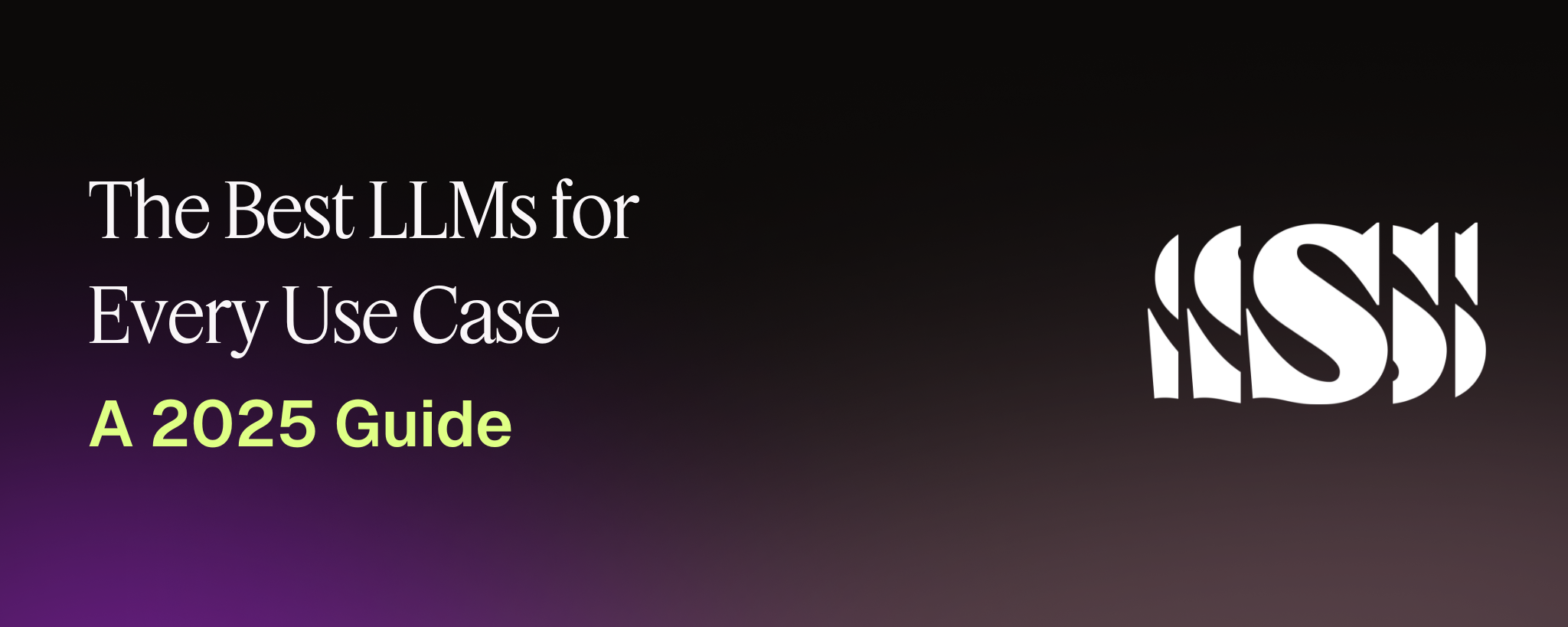The Best LLMs for Every Use Case: A 2025 Guide

The AI model landscape in 2025 is vast, and evolving faster than ever. From ultra-fast assistants to deep reasoning systems, each model now serves a different purpose. Whether you’re building an autonomous agent network, a customer support chatbot, or a research assistant, choosing the right model can save time, cost, and headaches.
Here’s a guide to today’s top Large Language Models (LLMs), what they do best, and when you should use them.
ASI:ONE Mini
For Web3 and Autonomous Agent Systems
A Web3-native general-purpose LLM (128K context) built to orchestrate autonomous agents, excelling at everyday chatbot tasks and scheduling workflows with the ability to call external agents for real-time data and actions.
Best for: Agentic coordination, decentralized systems, and use cases requiring on-chain connectivity or Web3-native interoperability.
Mistral Large
For Multilingual and Research Applications
A 123B-parameter flagship model delivering near-GPT-4 performance with top-tier reasoning, robust multilingual understanding, and strong coding/math skills (with a large 128K-token context window). It is excellent for complex chatbot queries across languages and domains.
Best for: Research, global applications, multilingual reasoning, and teams needing open and transparent performance.
GPT-5
For General Intelligence and Deep Reasoning
OpenAI’s most advanced multimodal model (text & vision) that leaps beyond previous GPTs, featuring state-of-the-art capabilities in coding, math, and creative writing with far fewer hallucinations. It’s a unified system that can rapidly decide when to respond instantly or “think” deeply, even over huge contexts of hundreds of thousands of tokens, to provide expert-level chatbot answers.
Best for: Complex reasoning, creative ideation, long-context problem solving, and high-stakes enterprise applications.
GPT-5 Mini
For Fast, Scalable Chatbot Systems
A faster, compact variant of GPT-5 designed for lighter reasoning tasks. It maintains the same strong instruction-following and safety alignment as GPT-5 but with significantly reduced latency. It’s ideal for real-time chatbot interactions and high-throughput applications without much performance sacrifice.
Best for: Real-time customer service chatbots, lightweight assistants, and environments where response speed is critical.
GPT-5 Nano
For Ultra-Low Latency and Developer Tools
The ultra-compact, fastest GPT-5 tier optimized for tool-assisted conversations and low-latency responses. It trades some deep reasoning capacity for blisteringly quick replies, yet still upholds core instruction-following and safety features. Perfect for cost-sensitive, real-time chatbot systems and developer tools.
Best for: Embedded chatbots, live interfaces, and systems running at scale where cost and speed matter most.
Claude Sonnet 4.5
For Coding, Tool Use, and Long-Running Tasks
Anthropic’s most powerful Claude model, the world’s best coding and tool-use AI, which excels at building complex agents and using computers autonomously. It combines superior code generation and editing with strong multi-step reasoning and math abilities, enabling chatbots to reliably handle extended, complex tasks. It even maintained focus on 30+ hour problem-solving sessions in tests.
Best for: Developers, coding copilots, research assistants, and agentic workflows requiring autonomy and long-term consistency.
Claude Haiku 4.5
For Cost-Efficient Reasoning and Multi-Agent Systems
Anthropic’s fastest and most cost-efficient Claude, delivering near-frontier intelligence (matching the older Claude Sonnet 4 in coding, computer tool use, and agentic tasks) at roughly double the speed and one-third the cost. It is an ideal choice for latency-sensitive chatbots and multi-agent systems that still require advanced reasoning and coding prowess.
Best for: Startups, cost-conscious teams, and agent ecosystems needing scalable intelligence at speed.
Grok 4
For Real-Time Data and Logic-Driven Reasoning
xAI’s flagship model with a massive 128K-token context and built-in web/tool integration, allowing it to fetch real-time information and execute code. It was trained with an emphasis on step-by-step “first principles” reasoning, so it excels at providing up-to-date, logically rigorous answers. A standout for chatbots needing live data retrieval, complex problem-solving, and direct action execution in one system.
Best for: Data-driven agents, real-time assistants, and technical or research tools that rely on current information.
DeepSeek v3
For Open-Source Flexibility and Efficiency
A cutting-edge open-source MoE (Mixture-of-Experts) model (671B parameters total, 37B active per token) that rivals top closed models in knowledge and reasoning. It’s trained on an immense 14.8T token diverse dataset and outperforms other open LLMs, all while generating text 3× faster than its predecessor. An excellent all-round choice for chatbots requiring broad domain expertise, long context handling, and efficient performance.
Best for: Builders and researchers who want open-source freedom, scalability, and frontier-level reasoning without vendor lock-in.
Gemini 2.5 Flash
For High-Speed, Multimodal Workloads
Google DeepMind’s high-speed “thinking” model offering the best price-performance in the Gemini family. It is capable of rapid and well-rounded responses for everyday queries (with native multimodal input and a 1M-token long context). It even exposes its step-by-step reasoning process, making it ideal for responsive chatbots that need quick answers, tool integrations (via the Live API), and transparency in how answers are formed.
Best for: Summarization, internal tools, customer-facing chatbots, and systems requiring rapid context processing at scale.
Gemini 2.5 Pro
For Enterprise-Level Reasoning Depth
Google DeepMind’s most advanced Gemini model, built for solving the hardest problems with superior step-by-step reasoning and multimodal understanding. It excels at highly complex tasks like intricate coding or data analysis by internally “thinking” through problems, and it can comprehend vast inputs to give thorough, expert-level responses. A top choice when your chatbot demands the absolute best in reasoning accuracy and depth.
Best for: Enterprise-grade research assistants, AI copilots, and advanced reasoning systems where precision and context are critical.
Closing Thoughts
The age of “one-size-fits-all” LLMs is over. Today’s builders have a model for every purpose, from lightweight real-time assistants to autonomous, multi-day reasoning systems. The right choice depends on what you’re optimizing for: speed, depth, cost, or autonomy.
Whichever direction you take, the key is to match your model to your mission, because in 2025, performance isn’t just about intelligence. It’s about fit.